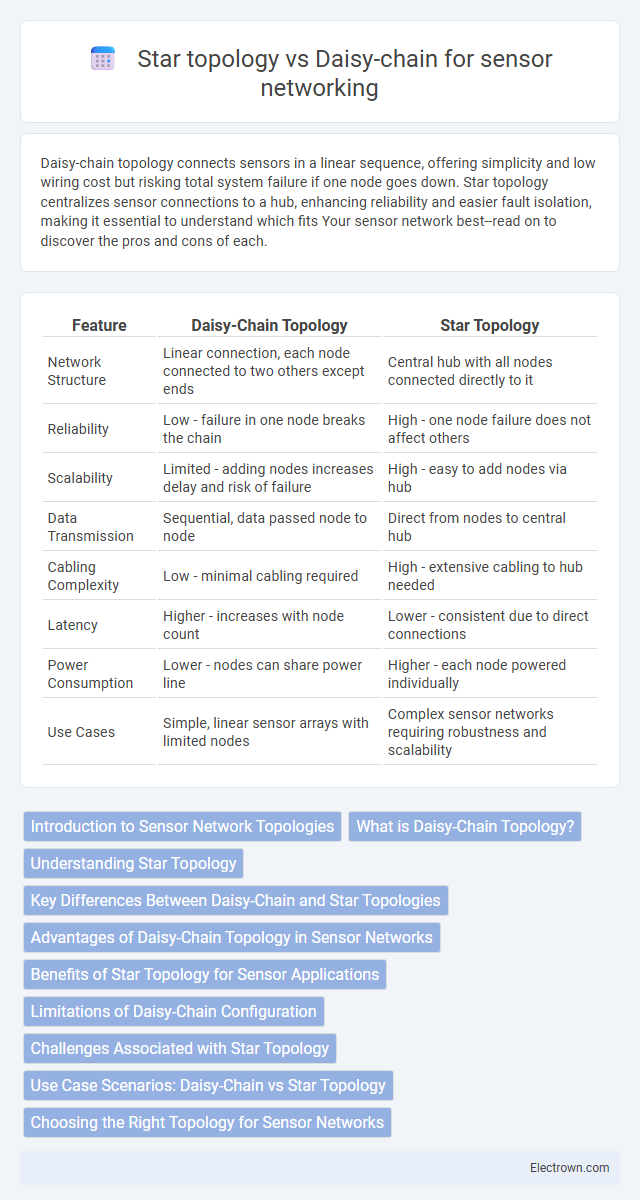Daisy-chain topology connects sensors in a linear sequence, offering simplicity and low wiring cost but risking total system failure if one node goes down. Star topology centralizes sensor connections to a hub, enhancing reliability and easier fault isolation, making it essential to understand which fits Your sensor network best--read on to discover the pros and cons of each.
Table of Comparison
| Feature | Daisy-Chain Topology | Star Topology |
|---|---|---|
| Network Structure | Linear connection, each node connected to two others except ends | Central hub with all nodes connected directly to it |
| Reliability | Low - failure in one node breaks the chain | High - one node failure does not affect others |
| Scalability | Limited - adding nodes increases delay and risk of failure | High - easy to add nodes via hub |
| Data Transmission | Sequential, data passed node to node | Direct from nodes to central hub |
| Cabling Complexity | Low - minimal cabling required | High - extensive cabling to hub needed |
| Latency | Higher - increases with node count | Lower - consistent due to direct connections |
| Power Consumption | Lower - nodes can share power line | Higher - each node powered individually |
| Use Cases | Simple, linear sensor arrays with limited nodes | Complex sensor networks requiring robustness and scalability |
Introduction to Sensor Network Topologies
Sensor network topologies, such as daisy-chain and star, play a crucial role in data transmission efficiency and fault tolerance. Daisy-chain topology connects sensors in a linear sequence, minimizing wiring costs but potentially increasing latency and vulnerability to single point failures. Star topology centralizes communication through a hub, enhancing robustness and ease of maintenance, though it requires more wiring and can face network disruptions if the central node fails.
What is Daisy-Chain Topology?
Daisy-chain topology is a network configuration where each sensor node connects sequentially to exactly two other nodes, except the end nodes, forming a linear chain. This setup reduces wiring complexity and cost but can result in higher latency and potential communication failure if one node breaks. It contrasts with star topology, where all nodes connect directly to a central hub, offering better network reliability and easier fault isolation.
Understanding Star Topology
Star topology features a central hub that directly connects to all sensor nodes, ensuring efficient data transmission and centralized control. This structure minimizes data collision and simplifies network management by isolating individual nodes, which enhances fault tolerance since failure in one sensor does not affect others. The star configuration is optimal for sensor networks requiring high reliability, scalability, and easy troubleshooting.
Key Differences Between Daisy-Chain and Star Topologies
Daisy-chain topology connects sensors sequentially, where each device links to the next, resulting in simpler wiring but higher vulnerability to network failure if one sensor breaks. Star topology features all sensors connected directly to a central hub, providing robust fault tolerance and easier maintenance but requiring more cabling and a central point of failure. Your choice between these topologies depends on network size, reliability needs, and deployment complexity.
Advantages of Daisy-Chain Topology in Sensor Networks
Daisy-chain topology in sensor networks offers simplified wiring and reduced cable length, lowering installation costs and minimizing physical clutter. It enables easier addition or removal of sensors without disrupting the entire network, enhancing maintainability and scalability for dynamic environments. This topology also supports sequential data transmission, which can optimize power consumption by allowing sensors to enter low-power states when not actively transmitting.
Benefits of Star Topology for Sensor Applications
Star topology offers centralized control and easy fault isolation, making it ideal for sensor networks where reliability is crucial. Each sensor connects directly to a central hub, ensuring minimal data collision and simplified network management. Your sensor application benefits from enhanced scalability and straightforward maintenance, improving overall system performance and uptime.
Limitations of Daisy-Chain Configuration
The daisy-chain topology in sensor networking suffers from significant limitations such as increased latency and reduced reliability since a single node failure can disrupt the entire chain. Its scalability is constrained due to cumulative signal degradation and bandwidth bottlenecks across sequentially connected sensors. These drawbacks make the daisy-chain less suitable for large-scale or critical sensor networks compared to star topology, which offers centralized control and fault isolation.
Challenges Associated with Star Topology
Star topology in sensor networking faces challenges such as single points of failure, where the central hub's malfunction disrupts the entire network. Scalability issues arise as adding more sensors increases the load on the central node, potentially causing congestion and latency. Limited range and reliance on direct communication with the hub restrict deployment flexibility and sensor placement in large-scale environments.
Use Case Scenarios: Daisy-Chain vs Star Topology
Daisy-chain topology suits linear sensor networks where devices are deployed in a sequence, such as environmental monitoring along pipelines or conveyor belts, minimizing wiring complexity and cost. Star topology excels in centralized sensor systems requiring robust performance and easy maintenance, common in smart home automation and industrial control where sensors communicate directly with a central hub. Both topologies balance trade-offs between scalability, fault tolerance, and latency based on deployment environment and application criticality.
Choosing the Right Topology for Sensor Networks
Choosing the right topology for sensor networks impacts reliability and scalability; star topology offers centralized management with easy troubleshooting, ideal for small to medium networks. Daisy-chain topology provides simplified wiring and reduced cost by linking sensors sequentially, but it may suffer from single-point failures affecting the entire chain. Your selection should balance network size, fault tolerance, and maintenance requirements to optimize sensor performance.
Daisy-chain vs Star topology for sensor networking Infographic

 electrown.com
electrown.com